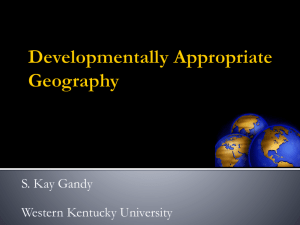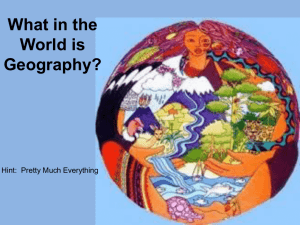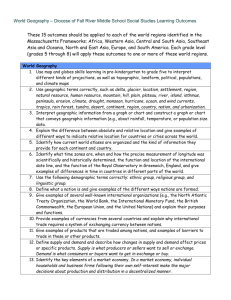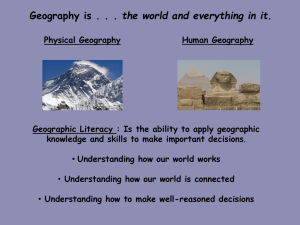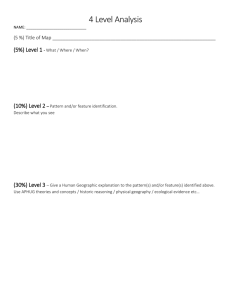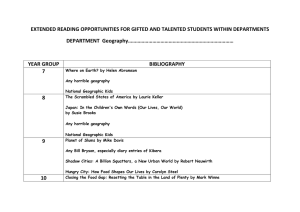Today’s Talk Five Themes of Geography
advertisement
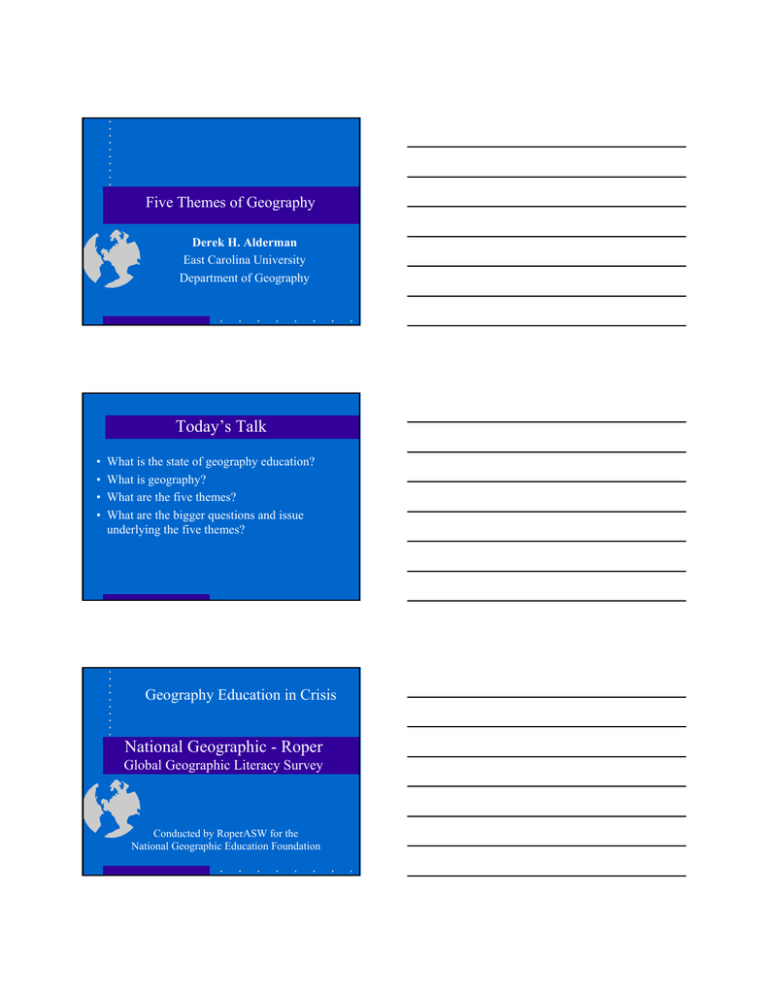
Five Themes of Geography Derek H. Alderman East Carolina University Department of Geography Today’s Talk • • • • What is the state of geography education? What is geography? What are the five themes? What are the bigger questions and issue underlying the five themes? Geography Education in Crisis National Geographic - Roper Global Geographic Literacy Survey Conducted by RoperASW for the National Geographic Education Foundation Methodology • Survey of 18- to 24-year-olds in nine countries: Canada, France, Germany, Great Britain, Italy, Japan, Mexico, Sweden and the U.S. Overall Results Average # of correct answers out of a possible 56 correct 56 42 40 38 38 34 31 28 27 28 23 21 U.S. Mexico 14 0 Sweden Germany Italy France Japan Great Britain Canada Sample: 18- to 24-year-olds World Hotspots Percentage of young adults naming Afghanistan as the base of the Taliban/al Qaeda 100% 84% 84% 82% 80% 79% 75% 71% 70% 63% 60% 58% 40% 20% 0% Sweden Great Britain Italy Germany Canada Japan France Mexico U.S. Sample: 18- to 24-year-olds World Hotspots Percentage of young U.S. adults correctly identifying Afghanistan on a world map 100% 80% 60% Incorrect/ don't know 83% 40% Correct 20% 17% 0% Afghanistan Sample: U.S. 18- to 24-year-olds Pop Culture Percentage of young U.S. adults correctly identifying Afghanistan on a world map vs. knowing where the last season of “Survivor” was filmed 100% 80% 83% 60% Incorrect/ don't know 66% 40% Correct 20% 34% 17% 0% Afghanistan Survivor Sample: U.S. 18- to 24-year-olds Country Location Skills 100% Percentage of young Americans who simply said “I don’t know,” when asked to find ___ on a world map 80% 60% 49% 46% 46% 45% 42% 40% 36% 25% 15% 20% 0% Afghanistan Israel Sweden Egypt U.K. France Russia Pacific Ocean Sample: U.S. 18- to 24-year-olds State Location Skills Percentage of young Americans correctly identifying ___ on a map of the United States 100% 89% 89% 80% 60% 51% 49% 44% 38% 40% 35% 31% 30% 30% Mass. N.J. Missouri 20% 0% Calif. Texas N.Y. Penn. Ill. Mich. Ohio Sample: U.S. 18- to 24-year-olds U.S. Population Percentage of young adults correctly identifying... 100% Own country's population 95% U.S. population 84% 75% 80% 68% 64% 58% 55% 60% 45% 43% 40% 40% 34% 56% 47% 44% 37% 35% 25% 20% 0% Sweden Japan Germany France Italy Great Britain Canada Mexico U.S. Sample: 18- to 24-year-olds U.S. Population Percentage of young Americans believing the U.S. population falls within the following ranges 100% 80% 60% Nearly one-third of U.S. young adults think the U.S. population is between 1billion and 2 billion, or nearly one-third of the total world population! 40% 20% 25% 31% 28% 25% U.S. 18-24 U.S. 25-34 30% 29% 12% 10% 6% 6% 0% 10 million to 50 million 150 million to 350 million 500 million to 750 million 1 billion to 2 billion Don't Know Sample: U.S. respondents Media is not always a good teacher Sometimes textbooks aren’t helpful either… Geography: A Primer • What is geography? – Poorly understood discipline – Popular View: A body of information and facts – In Reality: A perspective of the world and how it works • What is a geographic perspective? – More than simply memorizing the names of capitals and rivers Five Themes of Geography 1. 2. 3. 4. 5. Location Place Movement Human-Environment Interaction Regions Theme of Location • Why does location matter? – Part of one’s identity and frame of reference • Territoriality – Basis of our communities • Vote by district and state—Why? – Source of opportunities and constraints in people’s daily lives • Spatial mismatch of where you live and where you work – Shapes interactions and connections between places • Neighborhood effect Rejoin Pangaea (super-continent) 2 traditional expressions of location • Absolute Location • Relative Location—Situation Absolute Location • Absolute Location – Position or site in terms of geographic coordinate system – Often Mathematical – Most common: Latitude & Longitude – Another form: Street address – Unique identification in space Imp. Facts about Lat. And Long. Latitude Longitude Min-max values 0-90 deg. 0-180 deg. Major lines Equator (0) Poles (90) Prime Meridian (0) Intl. Date Line (180) Lines Parallel Converge at poles Measures N-S of Equator E-W of Prime Meridian Relative Location • Relative Location – Position in relation to other places – How a place interacts or connects with rest of world (its situation) – Related to accessibility—ease with which to reach – Location in relation to transportation, communication, external connections Panama • Absolute Location: 8° 58' N 79° 33' W • Relative Location: Middle America, borders and connects (with canal) Caribbean Sea and the North Pacific Ocean, bridge between Colombia and Costa Rica Bigger questions related to location 1. Don’t stop at: Where are things located? 2. Why are things located where they are? 3. How are things in one location related to things in another location? (spatial patterns) – Maps important for studying patterns Epicenters of Earthquakes GIS Analyzes Earth as Layers of Information Global Positioning System Initially developed by military Now widespread Brazilian Rainforest Deforestation False color infrared Shrinking Aral Sea Thermal Radiation Image of WTC, 9/2001 Maps are powerful tools If a picture is worth a thousand words, then a map is worth ten thousand words. Thematic Dot Map Maps can be fun: Cartogram worldmapper.org Population National Income Malaria Deaths McDonalds Fast Food Beware of Mercator Projection Toponyms • Another expression of location to be explored in the classroom • Also known as place-names • Names also provide clues to culture Place names • Ethnic origins – French and Spanish names in Louisiana – Dutch names in South Africa • Political Change – Russia: St. Petersburg to Leningrad to St. Petersburg – US: German-based names changed in WW I • Commemorate National Leaders – Washington • Name of state, national capitol, 31 counties – MLK • Over 890 cities have streets named for King; Over 110 public schools Location/Place Name Exercise • Turn students into map-makers—best way to learn locations • How many cities named Greenville in US? – http://geonames.usgs.gov/pls/gnispublic/ – Twenty – Compare climate, population, and economics in one Greenville versus another – Leads to discussion of how location affects way of life and how people live Theme of Place • Traditionally studied as collection of cultural and physical characteristics • Physical characteristics – Climate, soil, water, wildlife, etc. • Cultural characteristics – Human imprint or impact on a place – Built environment—buildings, roads, etc. Bigger questions related to place 1. How are places different from each other? 2. How are places similar to each other? 3. What factors explain these similarities and differences? (processes) – Photographs helpful in exploring places in classroom Suburbs in 3rd World Crowded Bangladesh New York Blackout--2003 Farming in Zimbabwe vs. Canada 19th Century Paris Sense of Place and Mental Maps • Place is not just set of objective facts • Sense of Place – The subjective, psychological attachment to place • Mental maps – How we perceive the physical arrangement of places – How we feel about or value places Fig. 8.4 Fig. 8.p284 Mental maps of children aged 6, 10, and 13. Mental Map Exercise • Ask students to draw map of a place (school, neighborhood, state, country, etc.) – Assess their voids in geographic knowledge – How do these maps vary by student and why? • Ask students to tell you what places they love or fear and why – Topophobia – Topophilia – People's descriptions of a place reveal their values, attitudes, and perceptions What shapes our mental maps? • • • • • Education Mass Media (from news to movies) Income/Social Class Personal Prejudice/Social Experience Travel/tourism Theme of Movement Geographers study movement of: – Goods (exports/imports, trade) – Ideas (fads, fashion, information, media) – People (tourism, migration, commuting) Watching solar powered TV in Niger Bigger Questions Related to Movement – How does the movement of people and things alter places and change lives? – What factors shape patterns of movement? – How is the movement of people and things open to debate? Voluntary Movement Involuntary Movement Contested Movement Why Do People Migrate? • Result of push and pull factors • Push factors: conditions or perceptions that induce people to move away from their home or origin (usually negative) • Pull factors: conditions or perceptions that tend to attract people to a destination (usually positive) Cultural Diffusion • Cultural ideas spread from an origin – Chinese fortune cookie is actually Japanese – Chewing gum originates with Native Americans • Cultural ideas spread in distinctive patterns – Contagious (Rumor or Fad) – Hierarchical (Fashion & Technology) – Reverse-hierarchical (Wal-Mart) Store Wars---Ashland, VA Cultural Globalization Imported Global Culture Local Culture Hybrid Glocal Culture Glocalization – adapting global imported culture to local cultures – a hybrid mixture of global and local Chamber of Fear Global spread of culture can be controversial Movement Exercise • Students interview different relatives about their migration histories (where they moved to and from and why) • Students record and map origin of products found at home (food, clothing) • Students write letter to a friend describing their hometown as if the automobile had never been invented Theme of Human-Environment Interaction – How the environment influences human activities – How humans depend on the environment – How humans modify the environment – How humans adapt to the environment Bigger Questions Related to Human-Environment Interaction – How is human-environmental interaction a complex cycle rather than one way relationship? – How does the human-environmental interaction have intended and unintended consequences? – How can we make the human-environmental interaction sustainable? Ski Resort in Whistler Mountain, BC, Canada Fig. 1.2 Fig. 1.1b Flooding in Indonesia June 21, 2006 stage = 18.4 ft Normal stage = 8 ft Floyd = 29.7 ft Coastal Overdevelopment: Sea Level Rise Urban heat island Nonrenewable vs. Renewable Resources Soil Erosion Coastal Erosion Fig. 1.7 Petrochemical Pollution in Texas City, TX Tires and Mosquitoes Big Issue: Invasive Species The Role of Humans Nutria in Louisiana Human-Environment Exercise • Streets Education (www.streetseducation.org) • Students participate in activities to improve livability of streets • Livability includes environmental impacts, alternative transportation, safety, etc. • Student calculate AVO (Average Vehicle Occupancy) of street near school or home Regions • Basic building blocks in geography • Regions do not occur naturally but created by humans—sometimes arbitrary creations • Types of regions: – – – – Formal Functional Fiat Perceptual Formal Regions – Defined by homogeneity or sameness of a characteristic – Based on similar human or physical characteristic – Ex: Region of French Speakers Formal Region: Appalachia What do you call a generic soft drink? • • • • Coke Soda Pop Other http://popvssoda.com:2998/ Functional Region – Defined by interactions or connections with other places – Things usually flow into or out of a central node – Node can be bank, grocery store, smokestack Functional Region: Commuting Fields Fiat region • Region defined by political decision or process • Boundaries equal to political boundaries • Varies – – – – USA State of NC Pitt County 3rd voting District Perceptual Region • Regions as they exist in our heads • How we identify ourselves regionally through our activities • Also how we classify or group others (stereotype) – Third World – Developing World – Muslim World 0 0 - 10 % 10 - 50 % > 50 % Percent of GEOG 1000 students identifying state as "southern". Bigger questions related to regions • What role does scale play in people’s lives? • How are we part of different geographic levels of activities? • How do our lives operate simultaneously at different scales--local, national, and global? • How are we part of a world in which regional boundaries are constantly changing? Region Exercise • Sports geography • Study of the origin and distribution of players on sports teams as way of measuring shifting scale of human activities and culture • Record, tabulate, and map geographic origin of: – NASCAR drivers (How has a southern sport become more national?) – NHL Hockey (How has a Canadian sport become more global?) – Examine team rosters for different time periods to measure regional change over time Thank You
